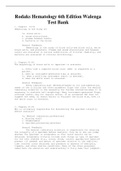Exam (elaborations)
Complete Test Bank Rodak’s Hematology 6th Edition Walenga Questions & Answers with rationales (Chapter 1-43)
- Course
- Institution
- Book
Rodak’s Hematology 6th Edition Walenga Test Bank Complete Test Bank Rodak’s Hematology 6th Edition Walenga Questions & Answers with rationales (Chapter 1-43) PDF File All Pages All Chapters Grade A+ GRADEXAM
[Show more]



